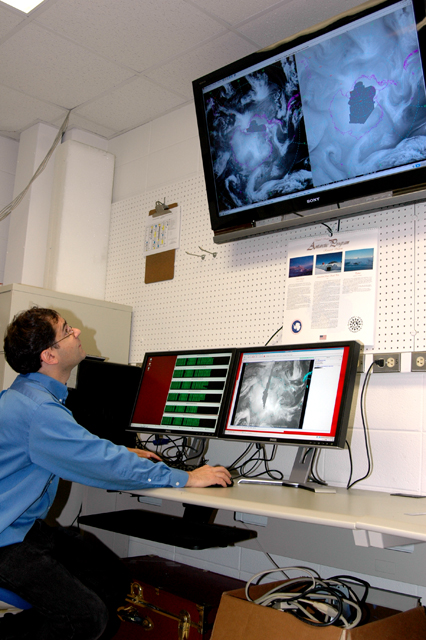Page 2/2 - Posted February 19, 2010
AMRC studiesIn another room at AMRC, a flat-screen monitor displays a graphic of Antarctica, pictured upside down from the image normally seen of the continent, with the Antarctic Peninsula pointing up. The perspective is deliberate: Lazzara wants to observe the wind and weather patterns between Antarctica and New Zealand, located in the upper left-hand corner in this view, because of the numerous flights along that route. The screen shows satellite images taken from the last 10 days, with swirls of clouds flashing across the picture as time leaps in one- or three-hour chunks. The image is composed of about 10 different geostationary (equatorial-orbiting) and polar-orbiting satellites. “It’s like doing a jigsaw puzzle. We’ve done it for many, many years every three hours. Now we’re doing it every hour, which is very exciting,” Lazzara says. The hourly composite has allowed his team to track clouds more accurately, which wasn’t possible with the every-three-hour compilations. That has provided the meteorologists a way to calculate wind speed — an estimate they previously used only polar orbiting or geostationary satellites to do. The hourly composites are timely enough to be useful to weather forecasters, he says. “It’s cheaper doing [the composites in] real-time. If you go back to build these later, it’s far more expensive,” Lazzara says. He has a different grant from the NSF for similar composites of the Arctic. There are some gaps in the imagery, however, as satellite coverage is not always available throughout the day. A full, data-rich image is possible, he explains, but it would take a day to complete and would not be as useful. “You can’t see the day evolve, which is what a weather forecaster wants,” he explains. Forecasters on the ground at South Pole Station To ensure the new and old equipment — located on the other side of the elevated station — were recording similar information, the sites ran simultaneously for a year. An analysis of the results from the instruments and visible observations on the ground found some striking disparities. “You would get [observations of] blowing snow that doesn’t match the wind speed. It’s because the profile of the station gets in the way,” Lazzara says. “South Pole is now big enough that it matters where you observe because it’s so large and influences the weather.” Lazzara’s own influences into the field of meteorology include his father, who worked as an environmental sciences high school teacher for 35 years. A native of Massachusetts, Lazzara ended up doing his graduate work at UW-Madison on the recommendation of a couple of undergraduate advisors who attended the university. In 1995, he made his first trip to Antarctica — and has been back seven times since, returning to the field for the 2009-10 summer season. “I have to admit that I like the Antarctic for the following reason, and it’s maybe one that you don’t think of: the sharing environment, the collaborations, a little less competitiveness,” Lazzara says. NSF-funded research in this story: Matthew Lazzara, University of Wisconsin-Madison, Award Nos. 0838834 |



For USAP Participants |
For The Public |
For Researchers and EducatorsContact UsNational Science FoundationOffice of Polar Programs Geosciences Directorate 2415 Eisenhower Avenue, Suite W7100 Alexandria, VA 22314 Sign up for the NSF Office of Polar Programs newsletter and events. Feedback Form |



